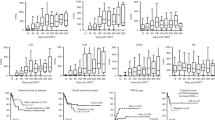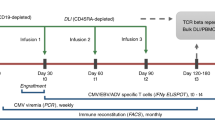Abstract
Since low T cell counts evaluated 1 month after allogeneic bone marrow transplantation (BMT) are associated with an increased risk of leukemia relapse (Powles et al., Blood 1998; 91: 3481–3486), we compared, in a randomized multicentric clinical study, the peripheral blood cells obtained 30 days after allogeneic BMT vs allogeneic G-CSF-mobilized peripheral blood stem cell transplantation (BCT) in an HLA-identical setting. T cell counts were higher 30 days after BCT (718 ± 142 cells/μl, n = 20) than after BMT (271 ± 53 cells/μl, n = 26, P = 0.006). However, T cells were less activated after BCT than after BMT, as demonstrated by a lower expression level of CD25 and a lower percentage of HLA-DR+ and CD95+ T cells. Furthermore, CD4+, CD8+and CD45RA+ post-BCT T cell counts correlated with the number of cells infused with the PBSC graft, while such a correlation was not observed between post-BMT counts and BM graft cell numbers, suggesting that the intensity of post-transplant peripheral lymphoid expansion and/or deletion differed between BCT and BMT. A comparison of the input of T cells expressing different CD45 isoforms with the post-transplant cell recovery further confirmed that, within the CD4+ T cell subset, post-transplant expansions occurred at a higher level after BMT than after BCT, affecting mainly the CD4+ CD45RO+subset. Altogether, our data demonstrate for the first time in a randomized setting that homeostasis of the T cell pool is less altered early after BCT than after BMT. This may have a strong impact on the graft-versus-leukemia (GVL) effect and subsequent relapse rate. Bone Marrow Transplantation (2001) 27, 167–175.
This is a preview of subscription content, access via your institution
Access options
Subscribe to this journal
Receive 12 print issues and online access
$259.00 per year
only $21.58 per issue
Buy this article
- Purchase on Springer Link
- Instant access to full article PDF
Prices may be subject to local taxes which are calculated during checkout




Similar content being viewed by others
References
Bensinger WI, Clift R, Martin P et al. Allogeneic peripheral blood stem cell transplantation in patients with advanced hematologic malignancies: a retrospective comparison with marrow transplantation Blood 1996 88: 2794–2800
Beelen DW, Ottinger HD, Elmaagacli A et al. Transplantation of filgastrim-mobilized peripheral blood stem cells from HLA-identical sibling or alternative family donors in patients with hematologic malignancies: a prospective comparison on clinical outcome, immune reconstitution, and hematopoietic chimerism Blood 1997 90: 4725–4735
Appelbaum FR . Choosing the source of stem cells for allogeneic transplantation: no longer a peripheral issue Blood 1999 94: 381–383
Dreger P, Haferlach T, Eckstein V et al. G-CSF-mobilised peripheral blood progenitor cells for allogeneic transplantation: safety, kinetics of mobilisation, and composition of the graft Br J Haematol 1994 87: 609–613
Körbling M, Huh YO, Durett A et al. Allogeneic blood stem cell transplantation: peripheralization and yield of donor-derived primitive hematopoietic progenitor cells (CD34+ Thy-1) and lymphoid subsets, and possible predictors of engraftment and graft-versus-host disease Blood 1995 86: 2842–2848
Bensinger WI, Weaver CH, Appelbaum FR et al. Transplantation of allogeneic peripheral blood stem cells mobilised by recombinant human granulocyte colony stimulating factor Blood 1995 85: 1655–1658
Körbling M, Przpiorka D, Huh, YO et al. Allogeneic blood stem cell transplantation for refractory leukaemia and lymphoma: potential advantage of blood over marrow graft Blood 1995 85: 1659–1665
Schmitz N, Dreger P, Suttorp M et al. Primary transplantation of allogeneic peripheral blood stem cells mobilised by filgrastim (granulocyte colony-stimulating factor) Blood 1995 85: 1666–1672
Trenschel R, Ross S, Hüsing J et al. Reduced risk of persisting cytomegalovirus pp65 antigenemia and cytomegalovirus interstitial pneumonia following allogeneic PBSCT Bone Marrow Transplant 2000 25: 665–672
Powles R, Singhal S, Treleaven J et al. Identification of patients who may benefit from prophylactic immunotherapy after bone marrow transplantation for acute myeloid leukaemia on the basis of lymphocyte recovery early after transplantation Blood 1998 91: 3481–3486
Charbonnier A, Sainty D, Faucher C et al. Immune reconstitution after blood cell transplantation Hematol Cell Ther 1997 39: 261–264
Ottinger HD, Beelen DW, Scheulen B et al. Improved immune reconstitution after allotransplantation of peripheral blood stem cells instead of bone marrow Blood 1996 88: 2775–2779
Powles R, Metha J, Kulkarni S et al. Allogeneic blood and bone-marrow stem-cell transplantation in haematological malignant diseases: a randomised trial Lancet 2000 355: 1231–1237
Blaise D, Kuentz D, Fortanier C et al. Randomised trial of bone marrow vs lenogastrim-primed blood cell allogeneic transplantation in patients with early-stage leukemia: a report from the Société Française de Greffe de Moelle J Clin Oncol 2000 18: 537–546
Przepiorka D, Weisdorf D, Martin P et al. 1994 Consensus conference on acute GVHD grading Bone Marrow Transplant 1995 15: 825–828
Tayebi H, Tiberghien P, Kuentz M et al. Comparison of HLA-identical allogeneic bone marrow (BM) versus peripheral blood stem cell (PBSC) transplantation: phenotypical and functional study of donor T cells in the graft and after hematopoietic reconstitution Blood 1998 92: 140a (Abstr.)
Schmidt-Wolf IG, Dejbakhsh-Jones S, Ginzton N et al. T-cell subsets and suppressor cells in human bone marrow Blood 1992 80: 3242–3250
Jin Y, Fuller L, Carreno M et al. The regulation of phenotype and function of human liver CD3+/CD56+ lymphocytes, and cells that also co-express CD8 by IL-2, IL-12 and anti-CD3 monoclonal antibody Hum Immunol 1998 59: 352–362
Wills MR, Carmichael AJ, Weekes MP et al. Human virus-specific CD8+ CTL clones revert from CD45ROhigh to CD45RAhighin vivo: CD45RAhigh CD8+ T cells comprise both naive and memory cells J Immunol 1999 162: 7080–7087
Boursalian TE, Bottomly K . Stability of naive and memory phenotypes on resting CD4 T cells in vivo J Immunol 1999 162: 9–16
Rocha B, Dautigny N, Peirera P . Peripheral T lymphocytes: expansion potential and homeostatic regulation of the pool sizes and CD4/CD8 ratios in vivo Eur J Immunol 1989 19: 905–911
Bell EB, Sparshott SM, Drayson MT, Ford WL . The stable and permanent expansion of functional T lymphocytes in athymic nude rats after a single injection of mature T cells J Immunol 1987 139: 1379–1384
Janossy G, Prentice HG, Grob JP et al. T lymphocyte regeneration after transplantation of T cell depleted allogeneic bone marrow Clin Exp Immunol 1986 63: 577–586
Martinez C, Urbano-Ispizua A, Rozman C et al. Immune reconstitution following allogeneic peripheral blood progenitor cell transplantation: comparison of recipients of positive CD34+ selected grafts with recipients of unmanipulated grafts Exp Hematol 1999 27: 561–568
Hakim FT, Cepeda R, Kaimei S et al. Constraints on CD4 recovery postchemotherapy in adults: thymic insufficiency and apoptotic decline of expanded peripheral CD4 cells Blood 1997 90: 3789–3798
Roux E, Helg C, Dumont-Girard F et al. Analysis of T-cell repopulation after allogeneic bone marrow transplantation: significant differences between recipients of T-cell depleted and unmanipulated grafts Blood 1996 87: 3984–3992
Brugnoni D, Airo P, Pennachio M et al. Immune reconstitution after bone marrow transplantation for combined immunodeficiencies: down-modulation of bcl-2 and high expression of CD95/Fas account for increased susceptibility to spontaneous and activation-induced lymphocyte cell death Bone Marrow Transplant 1999 23: 451–457
Hebib NC, Déas O, Rouleau M et al. Peripheral blood T cells generated after allogeneic bone marrow transplantation: lower levels of bcl-2 protein and enhanced sensitivity to spontaneous and CD95-mediated apoptosis in vitro Blood 1999 94: 1803–1813
Ibish C, Gallot G, Vivien R et al. Apoptosis of peripheral blood T lymphocytes early and late after bone marrow transplantation Blood 1998 92: 342a (Abstr.)
Small TN, Papadopoulos EB, Boulab F et al. Comparison of immune reconstitution after unrelated and related T cell-depleted bone marrow transplantation: effect of patient age and donor leukocyte infusions Blood 1999 93: 467–480
Elmaagacli AH, Beelen DW, Opalka B et al. The risk of residual molecular and cytogenetic disease in patients with Philadelphia-chromosome positive in first chronic phase myelogenous leukaemia is reduced after transplantation of allogeneic peripheral blood stem cells compared with bone marrow Blood 1999 94: 384–389
Champlin R, Schmitz N, Horowitz M for the International Bone Marrow Transplantation Registry and European Group for Bone Marrow Transplantation . Allogeneic blood stem cell (BSC) vs bone marrow in high risk but not low risk patients Blood 1998 92: (Suppl. 1) 657a (Abstr.)
Acknowledgements
We are indebted to all the clinical staff, cell therapy units and patients for their help and their contribution to this work, and namely Drs Attal M, Belhabri A, Boiron M, Bordigoni P, Bulabois CE, de Cervens C, Duval M, François S, Freycon F, Garban F, Guilhot F, Ifrah N, Jouet JP, Michallet M, Milpied N, Oriol P, Payen C, Pegourie B, Pico JL, Reiffers J, Rio B, Rohrlich P, Sadoun A, Sotto JJ, Sutton A, Vernant JP and Witz F. We also thank Mrs Joelle Beaune and Sandra Cournier for data management, Drs Gérard Socié and Anne Aupérin for critical and helpful reading of the manuscript and the Société Française de Greffe de Moelle for its support. This work was supported by grants from the Etablissement Français des Greffes, the Association pour la Recherche sur le Cancer and the Fondation de France.
Author information
Authors and Affiliations
Rights and permissions
About this article
Cite this article
Tayebi, H., Tiberghien, P., Ferrand, C. et al. Allogeneic peripheral blood stem cell transplantation results in less alteration of early T cell compartment homeostasis than bone marrow transplantation. Bone Marrow Transplant 27, 167–175 (2001). https://doi.org/10.1038/sj.bmt.1702753
Received:
Accepted:
Published:
Issue Date:
DOI: https://doi.org/10.1038/sj.bmt.1702753
Keywords
This article is cited by
-
Lymphocyte subset recovery following allogeneic bone marrow transplantation: CD4+-cell count and transplant-related mortality
Bone Marrow Transplantation (2008)
-
The presence and longevity of peripherally expanded donor-derived TCRαβ+ mature T lymphocyte clones after allogeneic bone marrow transplantation for adult myeloid leukemias
Leukemia (2003)
-
Compromised recovery of natural interferon-α/β-producing cells after allogeneic hematopoietic stem cell transplantation complicated by acute graft-versus-host disease and glucocorticoid administration
Bone Marrow Transplantation (2003)



